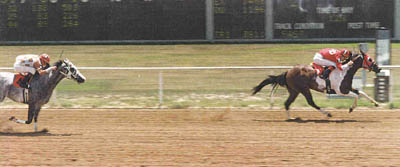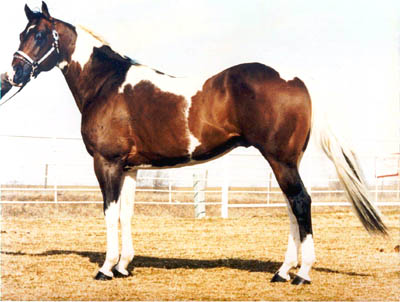History of Paint Racing
In the late 1940s, the beautiful Paint racehorse proved itself by defeating some
of the great Quarter Horses on the American Quarter Racing Association’s bush
tracks. Those winning Paints set the standard for today’s outstanding runners.
Paints were raced long before official recognition of the sport by APHA in 1966.
Some of the early-day Paint runners included Painted Joe, Painted Joe Jr.,
Little Nip and Little Beaver.

Runaway Rosie
During the past 38 years, Paint racing has shown tremendous growth, and Paint
Horses have continued to prove their racing ability on tracks throughout the
United States and Canada.
1966: Paint Horse racing was officially recognized. That year, the purse money
offered at the nine official races totaled $1,290. In comparison, in 2004, the
purses for the 785 recognized Paint races totaled $4,864,675.
The Oklahoma Paint Horse Club Futurity trials held in 1966 at Midway Downs in
Stroud, Oklahoma, were the first races recognized by APHA. Paint racing’s first
Register of Merit was earned in the second trial heat of that race. Painted
Jewel, a 1964 chestnut tobiano stallion owned by Art Beall, covered the 250-yard
course in 13.79 seconds to earn a AA rating and the ROM.
1970: The first running of the APHA National Championship Futurity took place at
the Colorado State Fair in Pueblo, on August 30. The bettors’ favorite was
Spoiler, but a striking chestnut overo colt named Slow Danger raced away with
the victory. Alfonso Gonzalez loaded his big colt back into the trailer and
returned home to South Texas with his $1,542 share of the purse. The race was
Slow Danger’s only official start of the year.
At 21 years of age, Painted Joe Jr. entered APHA’s official record books after
running a respectable second at a race held June 30 at Eureka Downs in Eureka,
Kansas.
1971: APHA recognized the speed index system for rating horses. The National
Championship races scheduled to be held in Pueblo were canceled and moved to
another location due to a VEE quarantine.
1973: Top Yellow became the first Paint racehorse to earn in excess of
$10,000 in a year. The Paint Stallion Breeders Association (PSBA) was also
formed this year. The sire subscription program (for Paints only) projected a
$35,000 purse for the first running of the futurity race in 1976.
1974: This year saw the largest crop to start in the 12-year history of Paint
racing, with 44 2-year-olds taking to the track. Paint racing was on the
upswing, with approved race days jumping from 35 the year before to 68, and
purses jumping from $46,293 to $83,469.
1980: A new generation of speedsters, which included Snazzy Indian and Cherry
Kiss, left an indelible mark on Paint racing when they each earned the fastest
speed ever index recorded by APHA. Cherry Kiss earned a 108 speed index in the
trials of the Open To The World Maturity at Ross Meadows in Ada, Oklahoma, while
Snazzy Indian earned his 108 speed index at Remington Park in Oklahoma City,
Oklahoma.

Easy Jet Too
1983: Easy Jet Too entered the Paint racing scene. Proclaimed by many to be one
of Paint racing’s greatest sires, the bay tobiano son of Easy Jet AQHA also
proved himself one of the breed’s greatest runners. His first start as a
2-year-old was challenging for the colt, but he won all nine of his remaining
races. Sky Jet was named World Champion Running Horse and posted an impressive
lifetime race record of 18 wins and 3 seconds out of 23 starts. Color Me Trouble
won the Champion of Champions at Sunland Park, New Mexico, which included eight
running champions in the field of 10. Paint racing made national TV when the
Oklahoma Paint Futurity, the Watermelon Special and the Champion of Champions
races were all shown on SPNW (Sports Network) on a delayed-basis nationwide.
1984: Pari-mutuel racing was brought to Oklahoma.
1987: Pari-mutuel wagering on horse racing became legal in Texas. Treasured, by
Easy Jet Too and out of Treasured Glass AQHA, shattered all records as a
2-year-old in 1985. The bay tobiano stallion earned more than $143,000 and took
home 16 percent of all winnings paid to Paints this year.
1989: Treasures, the next progeny of the golden Easy Jet Too and
Treasured Glass cross, was this year’s leading money-earning Paint Horse,
winning $71,017. Read more about the history of racing